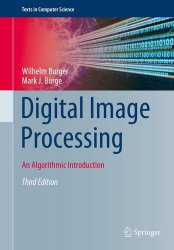Digital Image Processing: An Algorithmic Introduction, 3rd Edition
- Добавил: literator
- Дата: 29-04-2025, 00:16
- Комментариев: 0
 Название: Digital Image Processing: An Algorithmic Introduction, 3rd Edition
Название: Digital Image Processing: An Algorithmic Introduction, 3rd EditionАвтор: Wilhelm Burger, Mark J. Burge
Издательство: Springer
Серия: Texts in Computer Science
Год: 2022
Страниц: 937
Язык: английский
Формат: pdf (true)
Размер: 20.8 MB
This modern, self-contained textbook provides an accessible introduction to the field from the perspective of a practicing programmer, supporting a detailed presentation of the fundamental concepts and techniques with practical exercises and fully worked out implementation examples. This much-anticipated 3rd edition of the definitive textbook on Digital Image Processing has been completely revised and expanded with new content, improved illustrations and teaching material.
While we concentrate on practical applications and concrete implementations, we do so without glossing over the important formal details and mathematics necessary for a deeper understanding of the algorithms. In preparing this text, we started from the premise that simply creating a recipe book of imaging solutions would not provide the deeper understanding needed to apply these techniques to novel problems, so instead our solutions are developed stepwise from three different perspectives: in mathematical form, as abstract pseudocode algorithms, and as complete Java programs. We use a common notation to intertwine all three perspectives—providing multiple, but intimately linked, views of problems and their solution.
Topics and features:
Contains new chapters on fitting of geometric primitives, randomized feature detection (RANSAC), and maximally stable extremal regions (MSER).
Includes exercises for most chapters and provides additional supplementary
materials and software implementations at an associated website.
Uses ImageJ for all examples, a widely used open source imaging environment that can run on allmajor platforms.
Describes each solution in a stepwise manner in mathematical form, as abstract pseudocode algorithms, and as complete Java programs that can be easily ported to other programming languages.
Presents suggested outlines for a one- or two-semester course in the preface.
Prerequisites:
Instead of presenting digital image processing as a mathematical discipline, or strictly as a signal processing topic, we present it from a practitioner’s and programmer’s perspective and with a view toward replacing many of the formalisms commonly used in other texts with constructs more readily understandable by our audience. To take full advantage of the programming components of this book, a knowledge of basic data structures and object-oriented programming, ideally in Java, is beneficial. We selected Java for a number of reasons: it is the first programming language learned by students in a wide variety of engineering curricula, and professionals with knowledge of a related language, especially C# or C++, will find the programming examples easy to follow and extend.
Advanced undergraduate and graduate students will find this comprehensive and example-rich textbook will serve as the ideal introduction to digital image processing. It will also prove invaluable to researchers and professionals seeking a practically focused self-study primer.
Скачать Digital Image Processing: An Algorithmic Introduction, 3rd Edition
Внимание
Уважаемый посетитель, Вы зашли на сайт как незарегистрированный пользователь.
Мы рекомендуем Вам зарегистрироваться либо войти на сайт под своим именем.
Уважаемый посетитель, Вы зашли на сайт как незарегистрированный пользователь.
Мы рекомендуем Вам зарегистрироваться либо войти на сайт под своим именем.
Информация
Посетители, находящиеся в группе Гости, не могут оставлять комментарии к данной публикации.
Посетители, находящиеся в группе Гости, не могут оставлять комментарии к данной публикации.
